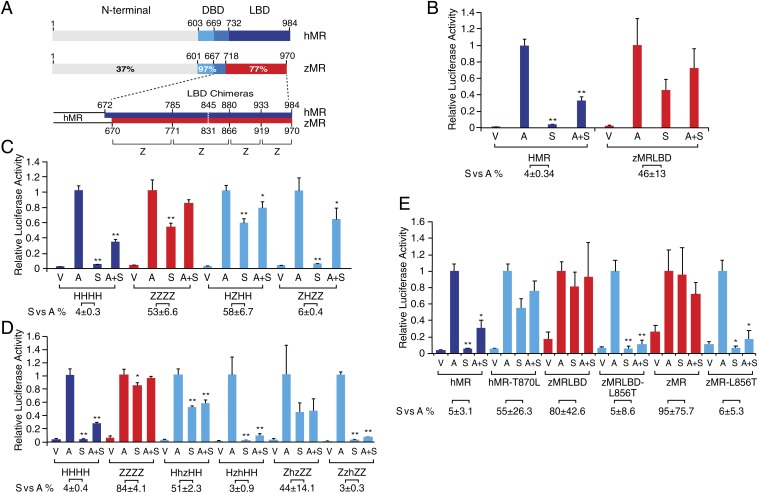Fig. 1.
Identification of the critical amino acid switch that determines agonism versus antagonism for spironolactone in the MR. (A) Schematic representation of the comparison of the hMR and zMR. The MR is divided into three principal domains: the N-terminal domain, the DNA-binding domain (DBD), and the ligand-binding domain (LBD). The amino acid numbers and the percentage amino acid identity are shown (6, 24). The architecture of the LBD chimeras is shown below with the amino acid numbers of the breakpoints shown above (hMR) and below (zMR). (B) Transactivation responses of hMR and a chimera of hMR N terminus and DBD with the zMR LBD (zMRLBD) to aldosterone and spironolactone. CV-1 cells were transiently transfected with 250 ng of pRShMR or pRSzMRLBD together with 250 ng of MMTV-LUC reporter gene and 50 ng of pREN-LUC. The cells were treated with vehicle (V), 10 nM aldosterone (A), 1 µM spironolactone (S), or aldosterone plus spironolactone (A+S). Corrected luciferase activity is expressed relative to the response of the hMR to 10 nM aldosterone (mean ± SEM) derived from two independent experiments with treatment groups aldosterone and aldosterone plus spironolactone being greater than vehicle alone (P < 0.05). Spironolactone and spironolactone plus aldosterone were less than aldosterone alone for hMR (**P < 0.0001) but not for zMR LBD. The activation with spironolactone alone as a percentage of that for aldosterone (S vs. A) for each MR is shown below the graph and significantly differs between the MR (P < 0.05). (C) Transactivation responses of hMR:zMR LBD chimeras to aldosterone and spironolactone highlighting the critical role of the second region in reciprocal chimeras. The four regions of the LBD are shown in A. Analysis is as in B with aldosterone and aldosterone plus spironolactone being greater than vehicle alone (P < 0.001). Spironolactone and spironolactone plus aldosterone are less than aldosterone alone (*P < 0.05, **P < 0.001) where indicated. The relative response, S vs. A, differs significantly (P < 0.001) between the wild type and its chimeric MR. (D) Transactivation responses with the second region of the LBD further subdivided as indicated by lowercase h and z. Spironolactone and spironolactone plus aldosterone are less than aldosterone alone (*P < 0.05, **P < 0.001) where indicated. The relative response S vs. A differs significantly (P < 0.001) for HhzHH but not HzhHH from HHHH and for ZzhZZ but not ZhzZZ from ZZZZ. (E) Transactivation responses of hMR 870 leucine and zMR 856 threonine. The response of WT hMR (hMR) and hMR threonine 870 leucine (hMR-T870L), and both the chimera, zMRLBD, and WT zMR (zMR) with leucine 856 threonine (zMR-L856T and zMRLBD-L856T, respectively) to aldosterone (A) and spironolactone (S) was examined as described above in three independent experiments. Spironolactone and spironolactone plus aldosterone are less than aldosterone alone (mean ± SEM, *P < 0.01, **P < 0.001) where indicated. The relative response, S vs. A, significantly differs between the intact MR LBD and the corresponding mutant MR LBD (P < 0.01).

